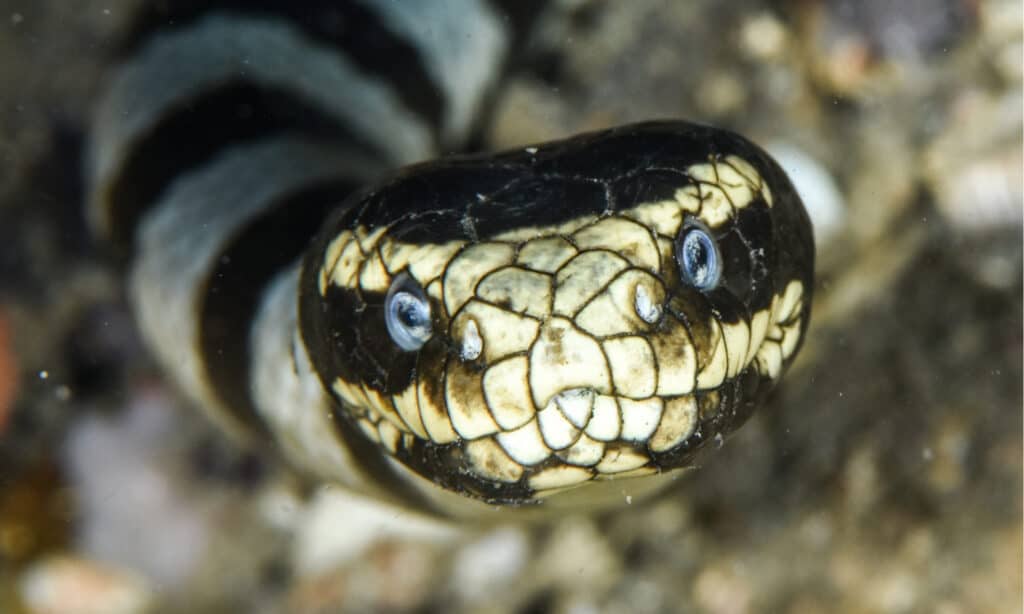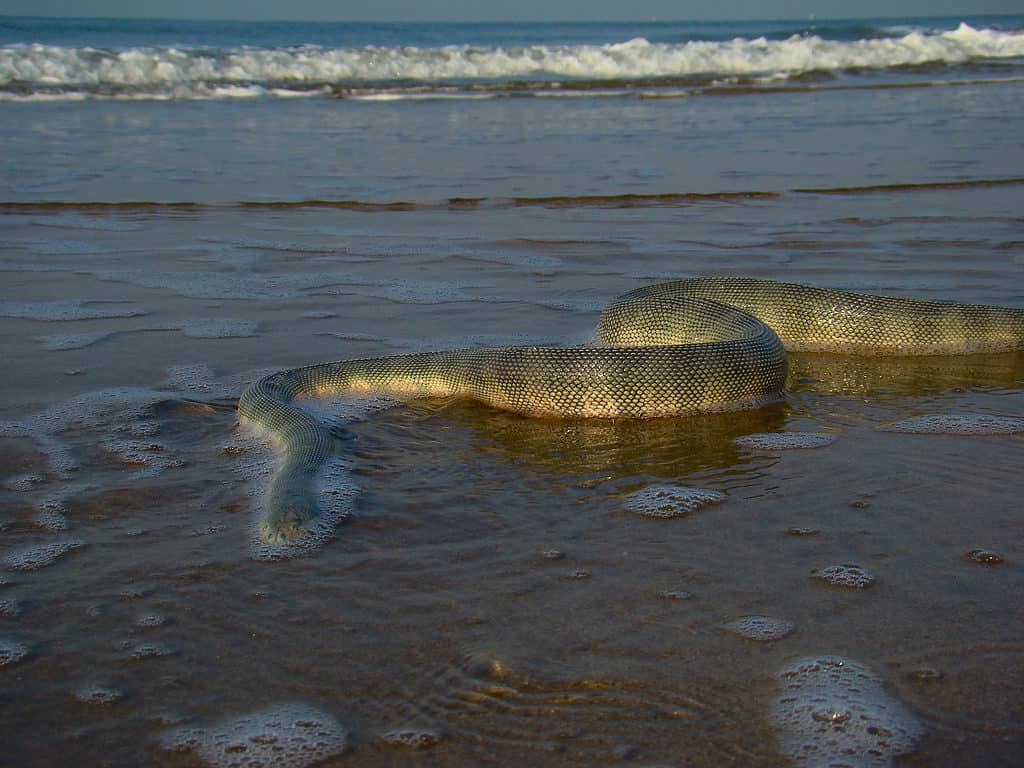Imagine this for a minute. You’re a time-traveling explorer going on another adventure in your time capsule. Unfortunately, your capsule is defective, and by a stroke of bad luck, you find yourself stuck on the coast of Morocco during the Eocene Epoch. You’re trying to determine the year, and your time map indicates it’s about 33.9 million years into the past.
Luckily, the issue with your ship is minor, and your partner volunteers to fix it quickly. While waiting for your partner to fix the ship, you take a quick dip in the prehistoric ocean to cool off. After a while of enjoying a swim in the cold prehistoric sea, you discover you’re not alone. There’s a giant 30-foot sea snake in the water, and it’s coming for you—gulp!
Of course, the chances of the above scenario happening are unlikely. But if you ever find yourself in a time capsule, avoid going for a swim as you might end up face-to-face with one of the largest snakes ever known, the 30-foot sea snake known as the Paleophis.
Scientific Name and Classification

While there is still much unknown about the 30-foot Paleophis sea snake, records indicate that the snake belongs to the Palaeophiinae family.
©Jack Pokoj/Shutterstock.com
Paleophis is an extinct genus of marine snakes from the Eocene Epoch. The name of this genus translates as “ancient snake,” which is fitting considering the age of the reptile. This marine reptile lived in aquatic environments in various locations worldwide.
This snake belongs to the Palaeophiinae (Palaeophiidae) family. Little is known about this subfamily of snakes. Records show that the genus and others within the same family lived from the Late Cretaceous to the Late Eocene. This was approximately 70.6–33.9 million years ago.
Description—How Big Was the Paleophis?
The reticulated python (Malayopython reticulatus) is one of the longest snakes in the world. This massive snake has an average length of about 29 feet and weighs close to 600 pounds. The longest one ever found was about 32 feet long. Nevertheless, it still would have been no match for the Paleophis if the marine monster was still living today.
The largest species in this genus is the Palaeophis colossus, which was known to have an estimated length of 29.5 feet to 40.4 feet. While this might not be massive by prehistoric standards since many ancient animals grew to enormous sizes, the Paleophis is still one of the largest known snakes. However, only some members of this genus were gigantic. The smallest member of the genus—Palaeophis casei—was only 4.2 feet.
Where Did Paleophis Live?

The largest member of this genus, the
Palaeophis colossus, is believed to have lived in the location of the present-day Sahara Desert.
©MrLis/Shutterstock.com
Based on the geological distribution of the fossils of this 30-foot sea snake, scientists have concluded that it was an aquatic animal. Fossils were mainly found in marine deposits. However, a few estuarine remains exist too.
While scientists agree with the general classification of this snake as a marine reptile, they probably occupied different ecological niches which varied from one species to the other. The reptiles inhabited a range of freshwater, estuarine, shallow marine coastal, and even open marine environments.
The subfamily is generally categorized into three grades based on their ecological distribution. There’s the primitive Paleophis grade which represents snakes that were slightly modified for aquatic life. Then there’s the advanced Paleophis grade which includes species whose vertebrae are clearly modified for aquatic life. The third category contains snakes that are highly modified for aquatic life.
The largest member of this genus, the Palaeophis colossus, is believed to have lived in the location of the present-day Sahara Desert. Although it is a subtropical dryland today, scientists think this location was once underwater. The now-extinct sea was known as the Trans-Saharan Seaway. It was home to the Paleophis and other prehistoric monsters.
Although snakes and many other reptiles today are cold-blooded, experts think the Paleophis was most likely warm-blooded. Studies of the snake’s vertebrae show a high degree of vascularization. This suggests that the snake probably had faster metabolism than modern snakes. In addition to rapid growth, it is believed that the reptile could regulate its body temperature internally, like warm-blooded animals. Interestingly, the Paleophis is not the only endothermic prehistoric reptile. The mosasaurs probably regulated their internal temperature this way too.
Discovery
Fossils of species within this genus have been found in various locations across Europe and Africa. This includes England, Denmark, France, Morocco, and Mali; a few remains have also been found in North America. The North American specimens were found in formations that date back to the Early Eocene.
Due to the poorly-preserved state of their fossils, members of this family are poorly known. The fossils found so far are mainly in the form of disarticulated vertebrae and ribs with a few vertebral segments. This has made it difficult to fully understand this snake’s appearance, habits, and habitats.
The recent discovery of isolated vertebrae and rib segments belonging to the Palaeophis maghrebianus in Africa has given us deeper insights into the massive size this snake family attained.
Is the 30-Foot Sea Snake Related to Any Living Snake?
In most fossil discoveries of this 30-foot sea snake, only vertebrae and rib bones are found. The lack of cranial bones has made it difficult for scientists to get an accurate understanding of the possible affinities of this snake. So far, their relationship with other groups of snakes is unknown.
Some scientists think they might be related to the boas and pythons, but there’s no conclusive evidence for this hypothesis. They are relatives of the Pterosphenus, another extinct genus of marine snakes that lived during the Eocene. Both snakes are members of the Palaeophiidae family, but they have no living relatives.
Is it Normal for Ocean Snakes to Be Large?

Venomous sea snakes can be quite dangerous,
©IHX/Shutterstock.com
There are a number of snake species that live in or near the ocean, but most of them tend to be relatively small. However, there are a few exceptions to this, and some ocean snakes can grow to be quite large.
One example of a large ocean snake is the olive sea snake, which can grow to be up to 2 meters (6.5 feet) in length. This species is found in the Pacific and Indian Oceans and is known for its distinctive olive-green coloration.
Another example is the yellow-bellied sea snake, which can also grow up to 2 meters in length. This species is found in tropical and subtropical waters around the world and has a bright yellow underside that helps to camouflage it against the surface of the water.
While these species of ocean snakes can grow to be quite large, they are still relatively rare compared to smaller species. In general, ocean snakes tend to be adapted to their specific environments and are often quite different from their terrestrial counterparts.
For example, they may have flattened tails or other adaptations that help them to swim more efficiently, and they may have developed specialized glands that allow them to excrete excess salt from their bodies. Overall, while it is not common for ocean snakes to be large, there are a few species that have adapted to grow to impressive sizes in order to thrive in their unique aquatic environments.
The photo featured at the top of this post is © Jack Pokoj/Shutterstock.com
Discover the "Monster" Snake 5X Bigger than an Anaconda
Every day A-Z Animals sends out some of the most incredible facts in the world from our free newsletter. Want to discover the 10 most beautiful snakes in the world, a "snake island" where you're never more than 3 feet from danger, or a "monster" snake 5X larger than an anaconda? Then sign up right now and you'll start receiving our daily newsletter absolutely free.
Sources
- Dinopeadia, Available here: https://dinopedia.fandom.com/wiki/Palaeophis
- Wikipedia, Available here: https://en.wikipedia.org/wiki/Palaeophiidae
- Wikipedia, Available here: https://en.wikipedia.org/wiki/Palaeophis
Thank you for reading! Have some feedback for us? Contact the AZ Animals editorial team.






